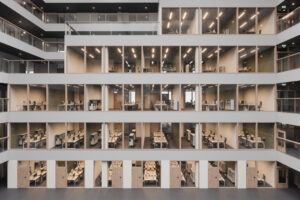
When cell phones struggle with poor signal strength indoors, calls are dropped, data speeds are slow, and occupants become frustrated. Enter Citizens Broadband Radio Service (CBRS)-based neutral host networks, an innovative solution rapidly gaining momentum and transforming indoor cellular connectivity.
Public cellular signals often struggle to penetrate building materials, resulting in weak or non-existent signals indoors. This problem is particularly acute in modern energy-efficient buildings with materials that block radio waves. While Distributed Antenna Systems (DAS) has long been a solution for extending public carrier signals into large venues, their high cost and lengthy deployment time make them impractical for smaller and medium-sized buildings.
CBRS uses the freely available and lightly licensed 3.5 GHz band, offering an accessible and cost-effective approach to improving indoor cellular coverage. Unlike traditional indoor coverage solutions that rely on dedicated operator-specific spectrum, CBRS-based neutral host networks use shared spectrum, which can be easily deployed in buildings of all sizes, from small offices to sprawling campuses. In the United States alone, there are over 130,000 buildings ranging from 100,000 to 500,000 square feet. This technology leverages multi-operator core network (MOCN) architecture, creating shared spectrum cellular networks that seamlessly integrate with major carriers’ networks and allow for the addition of private LTE or 5G network functionality with minimal extra investment.
Neutral host networks allow multiple cellular carriers to share the same network infrastructure. This approach reduces costs for building owners and provides better coverage for all users, regardless of their service provider. As a result, neutral host networks are becoming increasingly popular in multi-tenant buildings, hotels, universities, and other extensive facilities. Moreover, CBRS-based solutions can coexist with and complement existing Distributed Antenna System (DAS) infrastructure, extending capacity or cost-effectively addressing coverage gaps in large deployments. This versatility allows property owners to leverage their existing investments while enhancing overall cellular connectivity.
The adoption of CBRS-based neutral host networks is accelerating, with several high-profile deployments showcasing their effectiveness:
- Arizona State University: ASU is trialing a CBRS-based neutral host network with the help of Cox Private Networks and InfiniG, providing enhanced coverage for the university with the largest enrollment in the country. ASU’s central administration hub, the 150,000-square-foot University Services Building (USB), struggled with poor cellular coverage for years. Despite its proximity to bustling Phoenix, the building was essentially a mobile “dead zone,” frustrating students, staff, and visitors who couldn’t make calls or use data reliably. The CBRS-based neutral host model provided ASU a cost-effective solution to its connectivity challenges. The success in USB has paved the way for expanded mobility, IoT integration, and private network development across the entire campus.
- Nobu Hotel: This luxury hotel at Caesars Palace in Las Vegas deployed a CBRS-based neutral host network with the help of JMA Wireless to ensure seamless connectivity for guests and staff throughout the property. The MOCN architecture is at the heart of this deployment, enabling multiple mobile network operators to share the same equipment. Leveraging JMA’s private virtual RAN, Caesars Entertainment seamlessly integrated commercial services from multiple operators into a single, active production system covering all ten floors of the hotel.
- Meta: Meta (formerly Facebook) has implemented a neutral host in-building wireless network using the CBRS spectrum band across multiple locations, partnering with AT&T, Verizon, and T-Mobile. This solution, chosen over traditional DAS systems, proved 75% faster and more affordable to deploy while providing seamless roaming and consistent coverage.
- Gale Hotel: InfiniG has deployed its Mobile Coverage-as-a-Service (MCaaS) solution at the Gale Hotel in Miami Beach, providing seamless multi-carrier mobile coverage throughout the boutique hotel. The solution, developed in collaboration with Airspan and Druid Software, automatically connects guests to their preferred mobile network. The network provides robust cellular coverage throughout the property, enhancing guest satisfaction and operational efficiency.
- University of Virginia: UVA has embraced CBRS technology to improve cellular coverage across its sprawling campus. Kajeet, in partnership with Druid and Internet2, has deployed the neutral host network, which supports multiple carriers and has been particularly beneficial in areas with previously poor reception, such as underground spaces and older buildings.
As the demand for seamless connectivity continues to grow, CBRS-based neutral host networks are poised to become the go-to solutions for indoor & outdoor campus-wide public cellular coverage. Their ability to provide high-quality, cost-effective coverage for multiple carriers in buildings of all sizes makes them attractive to property owners, enterprises, and institutions.
Moreover, these technologies are well-positioned to support the expansion of 5G networks, which require denser infrastructure to deliver on their promise of ultra-fast speeds and low latency. As we move towards an increasingly connected future, CBRS-based neutral host networks will play a crucial role in ensuring that indoor spaces are not left behind in the cellular revolution.
To learn more about neutral host networks and choose a partner to help you achieve better indoor coverage, be sure to check out our member directory of experienced providers, HERE.
